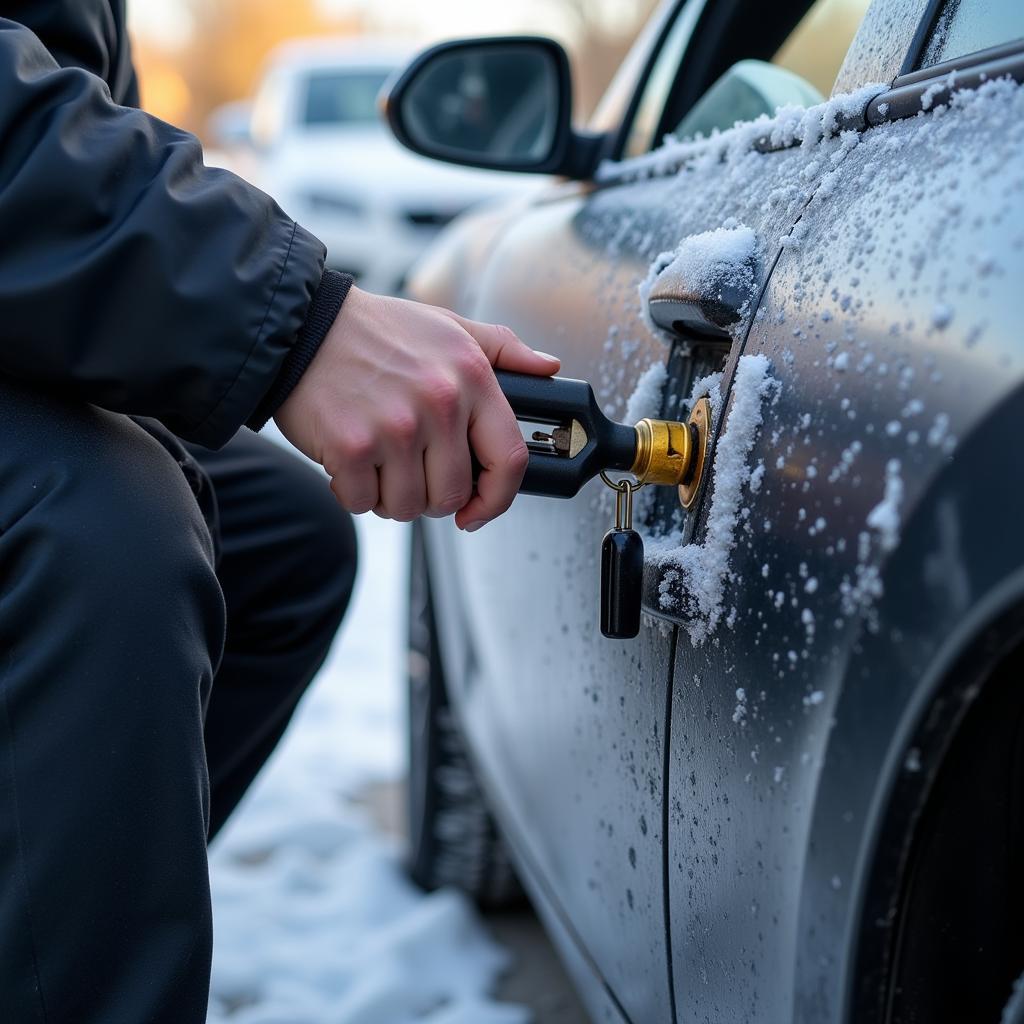Winter’s icy grip can bring more than just frosty mornings; it can also mean frozen car locks. This frustrating situation can leave you stranded and shivering, but don’t despair. There are several effective methods to fix frozen car locks, ranging from simple DIY solutions to professional assistance. Understanding the causes and preventative measures can also help you avoid this chilly predicament in the future.
Dealing with a frozen car lock can be incredibly frustrating, especially when you’re in a hurry. But don’t worry! There are some quick and effective solutions to get you back on the road. One popular method involves using a de-icer. Spray it directly into the lock, allowing it to work its magic for a few minutes before attempting to turn the key. Another option is to gently heat your car key with a lighter or match. The warmth can help melt the ice inside the lock. However, exercise caution with this method to avoid damaging your key or the car’s locking mechanism. For more detailed car repair advice, you can check out our guide on how to fix a muffler on a car.
Why Do Car Locks Freeze?
Car locks freeze due to moisture getting inside the locking mechanism. When temperatures drop below freezing, this moisture turns to ice, effectively jamming the lock. This can happen due to rain, snow, or even condensation. Understanding the root cause is the first step to finding a solution. You can learn more about repairing different parts of your car, such as fixing a hanging ceiling, on our website.
Common Causes of Frozen Car Locks
- Moisture: The primary culprit is water entering the lock.
- Freezing Temperatures: Below-freezing temperatures cause the water to freeze.
- Worn Seals: Damaged seals around the lock allow moisture to penetrate.
Effective Solutions for a Frozen Car Lock
Several methods can help you thaw out your frozen car lock. Some are quick DIY fixes, while others might require professional help. Remember to be patient and avoid using excessive force, which could damage the lock.
Using De-Icer
De-icer is a readily available solution specifically designed for frozen locks. Spray it directly into the keyhole, allowing it a few minutes to melt the ice.
Heating the Key
Carefully heat your car key with a lighter or match. Insert the warm key into the lock and hold it there for a few seconds. Repeat this process several times. Be cautious not to overheat the key, as this could damage the plastic or transponder chip. Looking for affordable ways to fix up your car? Check out our resources on fixer up cars.
Using a Hair Dryer
If you have access to a power outlet, a hairdryer can be an effective tool. Direct the warm air towards the lock, being careful not to hold it too close to avoid damaging the car’s paint.
Preventing Frozen Car Locks
Prevention is always better than cure. Taking a few preventative measures can save you the hassle of dealing with frozen car locks in the future. Here are a few tips:
Cover Your Locks
Covering your locks with a piece of tape or a magnet can help prevent moisture from entering. This simple trick can be surprisingly effective.
Lubricate Your Locks
Regularly lubricating your locks with graphite-based lubricant can help prevent freezing. Avoid using oil-based lubricants, as these can attract dirt and dust, potentially worsening the problem. Need help with your car’s alignment? We have a guide on the average cost to fix car alignment.
Park Indoors
Whenever possible, park your car in a garage or covered area to protect it from the elements. This will reduce the chance of moisture getting into the locks in the first place.
 Lubricating a Car Lock with Graphite
Lubricating a Car Lock with Graphite
When to Call a Locksmith
If all else fails, it’s time to call a locksmith. They have specialized tools and expertise to deal with frozen locks without causing damage. Attempting to force the lock yourself could lead to costly repairs. Another interesting fix you might want to explore is using ramen noodles to repair car parts, which you can read more about in our article on how to fix car with ramen noodles.
Conclusion
Frozen car locks are a common winter woe, but with a bit of knowledge and preparation, you can overcome this frosty challenge. Remember to prioritize prevention by covering and lubricating your locks. When faced with a frozen lock, try the DIY methods mentioned above. However, if you’re struggling, don’t hesitate to call a professional locksmith. For further assistance or advice, feel free to connect with us at AutoTipPro. Our phone number is +1 (641) 206-8880, and our office is located at 500 N St Mary’s St, San Antonio, TX 78205, United States.
 Locksmith Thawing a Frozen Car Lock
Locksmith Thawing a Frozen Car Lock
FAQ
- What is the quickest way to fix a frozen car lock? De-icer is often the fastest solution.
- Can I use WD-40 on a frozen car lock? While WD-40 might work temporarily, it’s not recommended as it can attract dirt and dust.
- How can I prevent my car locks from freezing? Cover your locks, lubricate them regularly, and park indoors whenever possible.
- Is it safe to heat my car key? Yes, but do so cautiously to avoid damaging the key.
- What should I do if I can’t unlock my car door after trying these methods? Call a professional locksmith.
- Can I use hot water to thaw a frozen car lock? This is not recommended as it could damage the lock and car paint.
- How much does a locksmith cost to unlock a frozen car door? Prices vary, but it’s typically less expensive than repairing a broken lock.





Leave a Reply